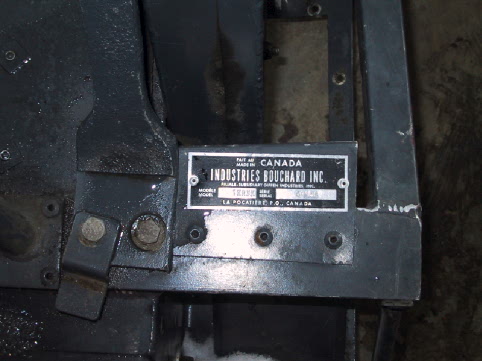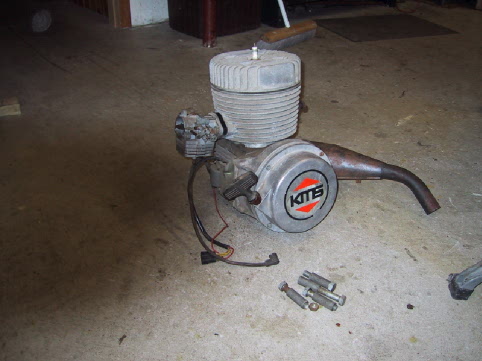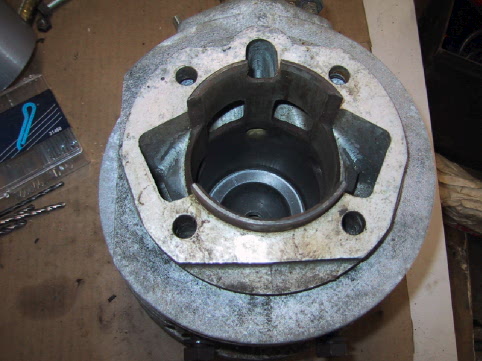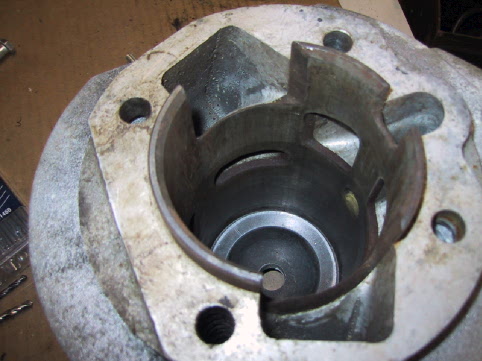|
The seat cover looks like someone let the air out of it! the speedo is missing, but i think i have one off another moto-ski we have. the 10 grand arrow tach is still there, and the needle still moves, so it might still work. the windshield didn't have a crack anywhere, which is a miracle. it cleaned up pretty nicely. might try to make a new one though. i think you can see in this picture how low and wide it is. the original gas tank is there, but has a huge crack along the bottom, that i don't think can be fixed. i have a lead on another eelco tank like on the puma that would make a nice replacement.

Here it is with the glass removed and sitting on the chassis. Not much to the entire front end of the sled. It is amazing that Moto-Ski could be so far ahead of their time with this racer in 1971, and all of it was thrown out. It is a shame and who would know what would have happened if they adopted this technology.

Note the chaincase and how far it hangs down on the sled. There is a stamped aluminum piece that gets riveted onto the glass and protects that case.

The aluminum suspension, aluminum bearing supports, aluminum tunnel, aluminum bulkhead, and aluminum chaincase really lighten this thing up!

Here is Adam standing next to it. The windshield doesn't make it any taller, that is how low it really is! He is 6'1" and the top of the hood is under his kneecap!

Look carefully at the serial number. There is no Moto-Ski name on it anywhere. The whole thing was made in Canada by Bouchard. the engine reminds me of a knock-knock joke. KMS who? The stock motor was a 338 KMS single free-air. Other engine sizes were a 292 single, 650 twin and 800 twin. I have been informed that these motors were very touchy and blew up more than they ran. The engine had porting down pat, but it just could not hold up. I have an idea of what will be coaxed into the chassis, and it should really rip @$$!!!

The motor looks like a Belgian waffle iron gone bad!!!
Most people give some really weird looks when you ask if they have any KMS motor parts. The KMS motor line was only used in the moto-ski bullets, making them ultra rare. I have been told that the company that produced the KMS motors had two plants. One in Japan and one in Canada. Apparently they used poor grade aluminum to make the most vital part of the motor, the pistons. This particular bullet got off pretty easy, it holed a piston, instead of a complete meltdown that took out the top end.
i have also been told that the 292 version of this motor was even more radical and made even more power than the 340, but the 292's were so unreliable that most never even completed a race. A STOCK 292 KMS in the bullet chasis was said to run at 92 mph on a quarter mile track.
KMS made a single cylinder 292, single cylinder 340, a twin 650, and a twin 800. All motors were free air.
It is a real shame these motors never panned out, because they had everyone whipped with a great design. Who knows what a good tuned pipe and mikuni carb could have done to them.
Since the motors were such bombs it is VERY common to see other engines put in bullets. Hirths, Sachs, Yamahas, and even Kawasakis have found their way into bullet chassis.

The pipe is in perfect shape, but I don't think the 90* bends help smooth exhaust exit. A nice power robbing factory feature


What the pipe lacked the ports made up for it. Look at the size of those ports! The layout of this cylinder is picture perfect. The exhaust, intake, and transfer are immense and would flow mega air. Take a deep breath and admire the engineering marvel before you.

Here is the bottom end of a KMS motor. The spacing between the crank and cases are extremely tight creating tons of crankcase compression to jam the fuel/air mixture threw the huge transfer ports at high speed, thus making huge power.
The ignition is points, and the crank is a full circle type. The recoil uses a cable instead of a rope, and unlike most other motors of the time this one has no spot to add an electric starter. This was built for one thing, and one thing only.

| 
